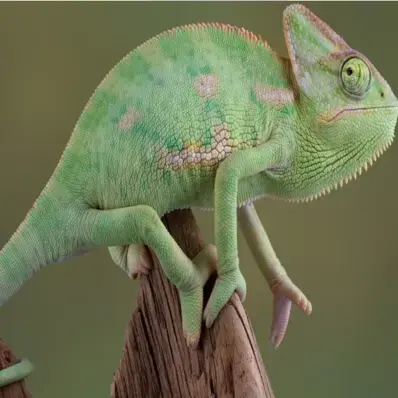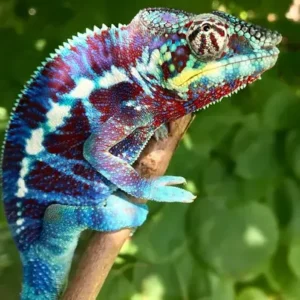History/Origin
Veiled chameleons, scientifically termed Chamaeleo calyptratus, trace their origins to the mountainous terrains of Yemen and Saudi Arabia. Indigenous to these regions, they have fascinated explorers and researchers for centuries with their remarkable ability to change colors and adapt to their surroundings.
The species gained widespread attention in the 20th century when they became sought-after commodities in the reptile trade. Initially prized for their striking colors and unique appearance, they soon became popular pets worldwide.
Their journey from the Arabian Peninsula to homes across the globe underscores their enduring allure and ongoing fascination with these captivating creatures.
Personality
Veiled chameleons possess intriguing personalities as pets, characterized by a blend of territorial instincts and curious exploration. Initially cautious around humans, they gradually acclimate to handling patient interaction.
Their independent nature often leads them to explore their surroundings with a sense of curiosity, making each interaction unique and engaging. However, during the breeding season, veiled chameleons can exhibit heightened aggression, particularly males competing for dominance. Understanding their behaviors and respecting their boundaries fosters trust and mutual respect between owner and pet.
Physical Appearance
Here is a description of the appearance of these reptiles:
- Size: Veiled chameleons typically measure between 17 to 24 inches in length, with males being larger than females.
- Color: Their bodies can feature a range of hues, including green, yellow, blue, and brown, often with intricate patterns and markings.
Gender Differences
In veiled chameleons, gender differences are notably distinct. Male specimens typically exhibit a larger physical stature compared to females.
One of the most prominent features distinguishing males is the presence of tarsal spurs located on their hind legs, which are absent in females. These spurs serve as indicators of sexual maturity and are absent in females.
Additionally, sexually mature males often boast brighter and more vibrant colors compared to their female counterparts. This striking difference in coloration further accentuates the visual contrast between female and male veiled chameleons, allowing for easy identification within the species.
Veiled Chameleon Diet and Nutrition
When it comes to feeding, veiled chameleons thrive on a diet primarily composed of insects:
- Diet Composition: Veiled chameleons primarily feed on insects such as crickets, roaches, and mealworms.
- Nutritional Value: Insects serve as excellent sources of protein and essential nutrients vital for chameleons’ health.
- Gut-loading: It’s crucial to gut-load insects with nutrient-rich foods before feeding them to chameleons to enhance their nutritional value.
- Supplementary Nutrition: Providing live plants within their habitat offers additional nutrition and hydration.
- Plant Consumption: Chameleons may occasionally consume plant matter, enriching their diet with vitamins and minerals.
Health
Like other reptiles, chameleons also face some common health concerns. Some of the most common are mentioned below:
- Eye Issues
Veiled chameleons may experience eye problems, including swelling, discharge, or cloudiness. These issues can result from various factors, such as inadequate humidity levels or exposure to irritants. Regular monitoring of their eye health is crucial for early detection and intervention.
- Infections
Respiratory infections are common in chameleons, often triggered by improper humidity levels or poor ventilation. Symptoms may include wheezing, nasal discharge, and lethargy. Prompt veterinary attention is vital to address infections and prevent complications.
- Nutritional Concerns
Metabolic bone disease (MBD) is a prevalent issue, stemming from calcium and vitamin D3 deficiencies. This condition can lead to weakened bones, difficulty moving, and deformities. Proper supplementation and a well-balanced diet are essential to prevent MBD.
- Physical Damage
Injuries, such as falls or improper handling, can result in physical trauma. Veiled chameleons are arboreal and can suffer harm if they fall from elevated perches. Ensuring a safe and secure habitat, as well as gentle handling, minimizes the risk of physical injuries.
Preventive Measures
To safeguard the health of your pet, ensure to prevent:
- Humidity Management: Maintain humidity levels between 50-70% to prevent dehydration and respiratory issues.
- UVB Lighting: Provide UVB lighting to facilitate proper calcium absorption, crucial for bone health.
- Balanced Diet: Ensure a diverse diet with gut-loaded insects and proper supplementation to prevent nutritional deficiencies.
- Regular Vet Check-ups: Schedule routine veterinary check-ups to detect and address health concerns early, ensuring a long and healthy life for your veiled chameleon.
Care and Grooming
Assuring optimal care and grooming for veiled chameleons involves the following practices:
- Enclosure Setup: Provide a spacious habitat with live plants for enrichment. Designate a basking area for thermoregulation. Also, install a misting system to maintain humidity levels.
- Habitat Maintenance: Regularly clean and sanitize the enclosure to prevent bacterial growth. Remove uneaten food promptly to avoid contamination.
- UVB Lighting: Ensure access to UVB lighting to support metabolic processes and overall health.
- Grooming Tasks: Ensure a clean water source is readily available. Promptly remove any uneaten food to maintain hygiene and prevent bacterial growth.
Rescue Groups
Several rescue groups and organizations specialize in the rehabilitation and rehoming of veiled chameleons. These groups often provide resources and support for owners facing challenges in caring for their chameleons.
Veiled Chameleon for Sale
Veiled chameleons are commonly available for sale through pet stores, reptile expos, and online breeders. Prospective owners should research reputable breeders and confirm proper veiled chameleon care before purchasing.
Interesting Facts
- Veiled chameleons can rotate their eyes independently, allowing them to look in two different directions simultaneously.
- They possess specialized feet with fused toes, enabling them to grip branches and climb with ease.
- Veiled chameleons have casques, or helmet-like structures, on their heads that aid in regulating body temperature and amplifying their calls.
Best For
Veiled chameleons make charming pets for reptile enthusiasts willing to provide the specialized care they require. Their unique appearance and behaviors add intrigue to any reptile collection.
Top Names
| Male Veiled Chameleon Names | Female Veiled Chameleon Names |
| Tango | Ivy |
| Rango | Cleo |
| Atlas | Nala |
| Blaze | Zara |
| Cosmo | Freya |










